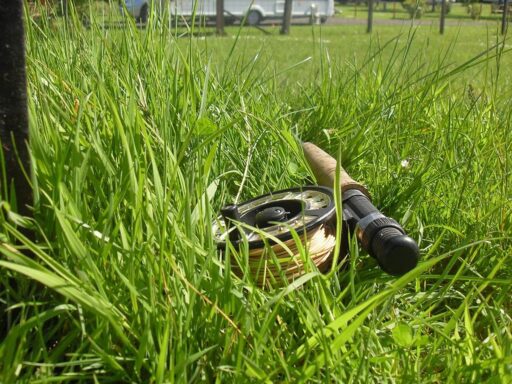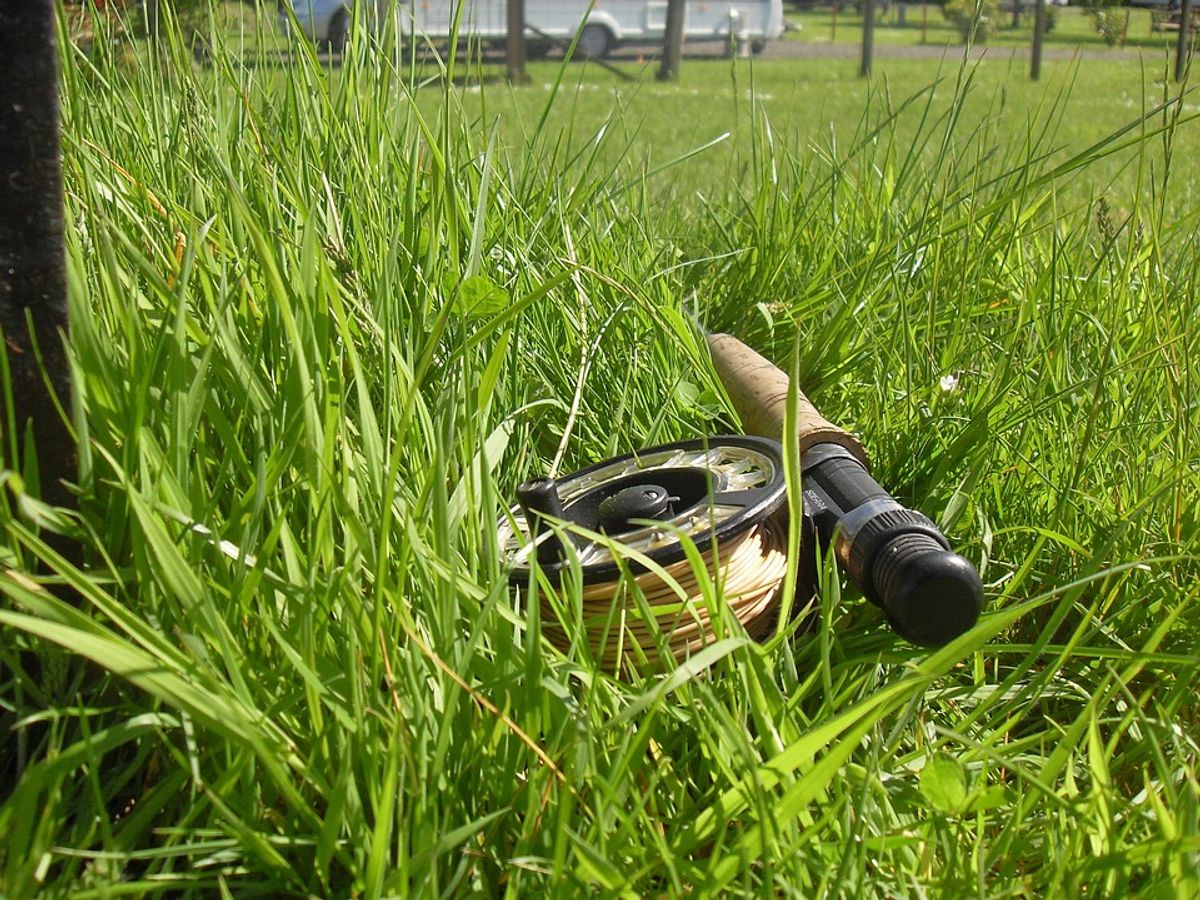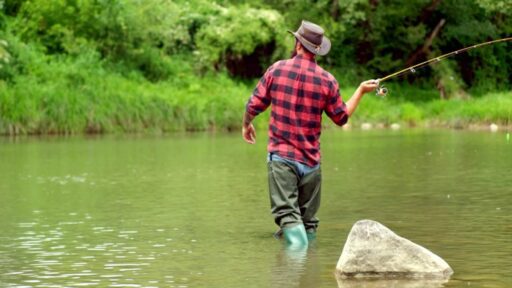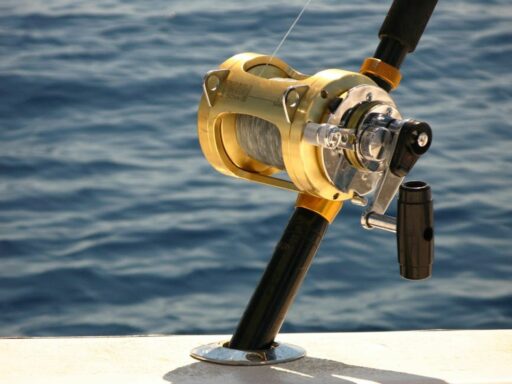Fly fishing for bass offers a thrilling and diverse angling experience, but the key to success lies in selecting the right gear. The choice of a bass fly fishing rod can make or break your outing, and with the myriad of options available, it can be daunting to pinpoint the ideal rod for your needs. In this ultimate guide, we’ll explore the critical factors in choosing the right bass fly fishing rod, tailored to various environments and techniques, to ensure you have the best possible experience on the water.
Key Takeaways
- The right bass fly fishing rod depends on the type of water you’re fishing, whether it’s rivers, lakes, or streams, each requiring specific rod characteristics.
- Rod specifications such as length, weight, action, and power are crucial in casting accuracy and technique, with a 9-foot, 6- to 8-weight rod being a versatile choice.
- High-quality fly lines and reels enhance the performance of your bass rod, with options like Scientific Anglers Amplitude and Cortland Line Company’s Bass Series being recommended.
- Essential flies and streamers, along with the right accessories, can significantly improve your bass fly fishing experience.
- Improving your skills through practice and learning from experienced anglers will increase your success in catching bass with a fly rod.
Understanding Bass Fly Fishing Rod Specifications

Rod Length and Its Impact on Casting
The length of your bass fly fishing rod significantly influences your casting capabilities. Shorter rods offer greater accuracy for close-range casting, making them ideal for tight spots or dense cover. Conversely, longer rods provide increased leverage and distance, allowing you to cover more water and reach distant targets.
- Short Rods (6′ – 7’6"):
- Better for precision casting
- Easier to maneuver in tight spaces
- Medium Rods (7’6" – 9′):
- Versatile for various situations
- Good balance of accuracy and distance
- Long Rods (9′ and above):
- Best for maximum casting distance
- Helpful in windy conditions or when fishing from a boat
When selecting a rod length, consider the typical fishing scenarios you’ll encounter. A well-chosen rod length can enhance your fishing experience by providing the right balance of accuracy, distance, leverage, and comfort.
Remember, the right rod length is not just about casting farther; it’s about casting smarter. Matching your rod to your fishing environment and technique is crucial for a successful fishing trip.
Choosing the Right Rod Weight for Bass
When selecting the right rod weight for bass fly fishing, it’s crucial to consider the type of flies you’ll be using and the conditions you’ll be fishing in. A 9-foot, 6- to 8-weight rod is often ideal for bass, especially when casting heavy flies and streamers. For instance, the Douglas Outdoors recommendation highlights a moderate-fast to fast-action 7 weight fly rod as the best choice for versatility and performance.
Here’s a quick reference table for rod weight selection based on fly size and fishing conditions:
| Fly Size | Recommended Rod Weight |
|---|---|
| Small to Medium | 5 to 6 weight |
| Large Streamers | 7 to 8 weight |
Remember, the right rod weight not only aids in accurate casting but also ensures that you have enough power to handle the bass once hooked.
Rod weight can also be influenced by the fishing environment. For big, fast waters, a 9′ 6wt rod or heavier is recommended. Personal preference plays a significant role, and some anglers find a 7wt rod to be a versatile option for various trout waters as well. Ultimately, the choice of rod weight should align with your fishing style and the type of water you’ll be exploring.
Action and Power: Tailoring Your Rod to Your Technique
When selecting a bass fly fishing rod, the action and power are crucial factors that directly affect your casting and fishing technique. The right combination of rod action and power can greatly enhance your control and sensitivity, allowing for more precise presentations and effective hook sets.
For instance, a fast-action rod will bend primarily near the tip, offering a stiffer backbone for longer casts and better wind penetration. This is ideal for situations where you need to cover more water or when fishing in windy conditions. On the other hand, a medium-action rod provides a balance between casting distance and accuracy, which is beneficial for a variety of bass fishing scenarios.
Here’s a quick reference to help you match rod action to your preferred techniques:
- Fast Action: Long casts, windy conditions, streamer fishing
- Medium Action: General use, versatility, dry-dropper rigs
- Slow Action: Delicate presentations, dry fly fishing
Remember, the power of the rod should complement the size of the fish and the weight of the line. A rod with too much power can make it difficult to cast small flies accurately, while one with too little power may struggle to handle larger bass or to cast in heavy winds.
Ultimately, the choice of rod action and power should reflect your personal fishing style and the conditions you most frequently encounter. Experimentation and experience will guide you to the perfect rod for your bass fly fishing adventures.
Selecting a Rod Based on Fishing Environments

River Fishing: Matching Rods to Currents and Cover
When selecting a rod for river bass fly fishing, the key is to balance the need for power with the ability to make delicate presentations. A 9′ 6wt rod is often the sweet spot for many anglers, providing enough backbone to handle larger fish and fight strong currents, while still being capable of presenting flies with finesse during a hatch.
In river environments, it’s crucial to have a rod that can manage the diverse challenges you’ll face, from navigating underbrush to casting in windy conditions.
Here are some recommended rods for river fishing:
- Sky G 9′ 5wt
- DXF 9′ 6wt
- LRS 9′ 5wt
- Upstream PLUS 9′ 6wt
Remember, the choice of rod can also be influenced by your preferred fishing technique. If you enjoy throwing streamers, a 6wt will generally serve you better. However, for dry flies and smaller presentations, a 5wt may be more appropriate. Always consider the type of water and the fishing conditions when making your selection.
Lake Fishing: Considerations for Still Water Tactics
When targeting bass in the still waters of a lake, your approach must adapt to the unique challenges presented by this environment. In warmer waters, a quicker retrieve may provoke an aggressive response from bass, contrasting with the slower, steady retrieves recommended for colder conditions. Bass are known to be more sluggish in the cold, so patience and a methodical approach can be key.
Bass often seek areas with cover such as weed beds and submerged structures. A strategic cast towards these features followed by a retrieval towards yourself can increase your chances of a successful catch. Pay attention to the lake’s topography, targeting drop-offs and other structures where bass are likely to congregate.
- Observe water movement at inlets and culverts, especially post-rainfall.
- Utilize nymphing techniques to entice bass accustomed to streamers.
- Adjust your retrieval speed based on water temperature and bass activity.
Remember, the right rod will enhance your ability to respond to these conditions, offering the sensitivity and power needed to work your fly effectively and handle the inevitable ‘big fight’ when you hook a bass.
Stream and Small Water Fly Fishing: Precision and Maneuverability
When fly fishing in streams and small waters, precision and maneuverability are paramount. The confined spaces and clear waters demand a delicate presentation to avoid spooking the fish. A lighter rod weight is often recommended for these environments, as it allows for more subtle presentations, especially during insect hatches where finesse is crucial.
In streams and creeks, where the water rarely exceeds 20 feet in width and 6-10 feet in depth, the choice of rod can make a significant difference. Wading access typically provides the angler with the opportunity to approach fish stealthily, but the right rod is needed to place the fly accurately.
For those seeking specific rod recommendations for stream and small water fly fishing, consider the following:
- Dry Flies: Upstream 8’ 6” 4wt, Sky G 9’ 5wt
- Dry-dropper-dropper: DXF 8’ 6” 4wt, LRS 8’ 6” 5wt
- Nymphs: Upstream PLUS 9’ 4wt, DXF 9’ 3wt
Remember, the goal is to match your fly to the natural diet of the bass in these waters. A versatile fly like the wooly bugger can be an excellent choice for beginners, cast parallel to the bank with focused retrieval motions to mimic natural prey movement.
Top Rod Recommendations for Bass Fly Fishing

Expert Picks: High-End Rods for Serious Anglers
When it comes to high-end rods for the serious bass fly fisher, the choices can be overwhelming. Selecting the perfect rod is a balance of power, action, and sensitivity to match the angler’s technique and the fishing conditions. For those dedicated to the pursuit of bass, investing in a top-tier rod can significantly enhance the fishing experience.
The right rod can mean the difference between a good day on the water and a great one. It’s not just about the catch, but how you feel every cast, every retrieve.
For example, the Sky G 9′ 5wt and the DXF 9′ 6wt are standout choices for river fishing, offering the backbone needed for dry-dropper-dropper rigs. On the other hand, the Orvis Helios D 8-foot, 5-inch 10 weight excels in strength and accuracy for larger fish like stripers.
Here’s a quick reference for some of the top rods recommended for different scenarios:
- River Fishing: Sky G 9′ 5wt, DXF 9′ 6wt
- Heavier Fish: Orvis Helios D 8’5" 10wt
- Big Flies: 9′ 6wt rods and up
Remember, the best rod for you is one that feels right in your hands and suits your fishing style. While the recommendations provided are based on extensive experience and testing, personal preference plays a crucial role in the final decision.
Best Value Rods: Balancing Quality and Budget
When it comes to bass fly fishing, finding a rod that offers both quality and affordability can be a challenge. Selecting a rod that meets your needs without breaking the bank is crucial for both novice and experienced anglers. A good value rod should have a balance of sensitivity, power, and durability to handle the rigors of bass fishing.
It’s important to remember that a higher price doesn’t always equate to better performance. Many mid-priced rods offer features and quality comparable to their more expensive counterparts.
Below is a list of recommended rods that provide the best value for bass fly fishing:
- Wild Water Fly Fishing Combo, 9 ft 5/6 wt – A versatile option with positive reviews, priced at $99.00.
- Douglas DXF 9′ 6wt – Known for its ability to handle various fishing techniques and water types.
- Douglas LRS 9′ 5wt – Offers a great combination of power and sensitivity for river fishing.
When comparing rods, consider not only the price but also the specific features that align with your fishing style and the environments you frequent. A well-chosen rod can enhance your fishing experience and improve your chances of a successful catch.
Specialty Rods: When to Choose a Niche Fly Rod
While most bass fly fishing rods are versatile enough to cover a variety of situations, there are times when a specialty rod can make a significant difference. Choosing a niche fly rod is about matching the rod to very specific conditions or techniques that require more than a general-purpose rod can offer.
For instance, if you’re frequently targeting bass in areas with dense cover or where precision is paramount, a shorter rod with a specific action may enhance your control and accuracy. Conversely, for long casts in open water, a longer rod might be the better choice.
Specialty rods can also be tailored to certain types of flies or presentations. For example, a rod with a softer tip might be ideal for delicate dry fly presentations, while a rod with more backbone might be necessary for turning over large streamers.
When considering a specialty rod, think about the following:
- The specific fishing conditions you encounter most often.
- The types of flies you prefer to use.
- Your personal casting style and technique preferences.
Ultimately, the decision to invest in a specialty rod should be based on the nuances of your fishing style and the environments you fish in most frequently. A well-chosen niche rod can be a valuable addition to your arsenal, providing an edge in situations where a standard rod might fall short.
Fly Fishing Gear Essentials for Bass

Reels and Lines: Complementing Your Bass Rod
Selecting the right reel and line is crucial for an effective bass fly fishing setup. The reel should balance well with your rod and have a smooth, reliable drag system. For lines, consider the type of flies you’ll be using and the conditions you’ll be fishing in.
- Scientific Anglers Amplitude Smooth Titan Long
- Cortland Line Company’s Bass Intermediate Specialty Series
These lines are designed to handle the larger, more wind-resistant flies often used in bass fishing. The Scientific Anglers line is known for its ability to turn over big flies and shoot them accurately, even in windy conditions. The Cortland Line, with its aggressive taper and intermediate tip, excels in getting your fly down in currents and around submerged structures.
When pairing your rod with a reel and line, think about the overall weight and feel. A well-matched setup will give you better control and sensitivity, allowing for more precise casts and effective retrieves.
Essential Flies and Streamers for Bass
When fly fishing for bass, the right selection of flies and streamers is crucial for success. Bass aren’t picky, but tend to like large, flashy presentations. Flies that mimic the natural prey of bass, such as tadpoles, crayfish, frogs, and baitfish, are particularly effective. Among the most popular categories are poppers, nymphs, and streamers.
The wooly bugger stands out as a versatile and beginner-friendly streamer. It can be cast parallel to the bank and retrieved with firm, focused motions to entice bass. Achieving the correct depth is essential, and an unweighted wooly bugger on a floating line will simulate a baitfish well.
For those looking to refine their fly selection, the BASSDASH Fly Fishing Flies Kit offers an assortment of dry/wet flies, nymphs, streamers, and poppers, suitable for various conditions and preferences. Here’s a quick list of some effective fly patterns for bass:
- Wooly Bugger
- Clouser Minnow
- Deceiver
- Frog Popper
- Crayfish Pattern
Remember, the key is to match the hatch and present your flies in a way that mimics the natural behavior of the prey.
Accessories: Enhancing Your Bass Fly Fishing Experience
Beyond the rod, reel, and line, the right accessories can make a significant difference in your bass fly fishing success. Proper selection and use of accessories can elevate your fishing experience, ensuring you’re prepared for various scenarios on the water.
Essential accessories include a durable fishing vest or pack to organize your gear, polarized sunglasses for better water visibility, and a reliable pair of waders for those who venture into the water. Additionally, a hat and sunscreen are indispensable for protection against the elements.
- Fishing Vest/Pack
- Polarized Sunglasses
- Waders
- Hat
- Sunscreen
Remember, the goal is to be comfortable and efficient on the water. Accessories should not only aid in your fishing but also protect you from the environment.
While not exhaustive, this list serves as a starting point. Tailor your accessory choices to your specific needs and the conditions you expect to encounter. With the right gear, you’ll be well on your way to a rewarding bass fly fishing adventure.
Improving Your Bass Fly Fishing Skills

Techniques and Presentations for Bass
Mastering the right techniques and presentations is crucial for successful bass fly fishing. Bass are eating machines, and presenting your fly effectively can make all the difference. A 7.5- or 9-foot leader in 2x to 4x is typically sufficient for most bass situations, with tippet in the same range. For larger fish, tying the fly directly into the leader can be effective.
When targeting bass, consider the cover they favor, such as weed beds, lily pads, downed trees, and submerged boulders. Cast towards these areas and retrieve back towards yourself, keeping in mind the natural structure of the body of water. Drop-offs and bottom structures are prime spots for bass.
Line management is key when fighting a bass. They are powerful and may jump, especially smallmouth bass. Maintain control by keeping pressure with your rod tip and give slack when they jump by "bowing" to the fish.
Remember, the first bass you hook will likely be a game changer, so prepare for an exhilarating experience and ensure your presentations are on point.
Learning from the Pros: Tips and Tricks
Gleaning wisdom from seasoned anglers can dramatically improve your bass fly fishing prowess. Always observe the water before casting; understanding the behavior of bass in their natural habitat is crucial. Here are a few tips from the pros:
- Study the feeding patterns of bass to choose the right flies.
- Practice casting in different conditions to master accuracy and distance.
- Learn to read the water and identify potential bass hot spots.
- Refine your retrieval technique to mimic natural prey movements.
Remember, the subtleties of your technique can make a significant difference. Paying attention to the rhythm of your cast and the smoothness of your line can turn near misses into successful catches.
Additionally, don’t underestimate the value of local knowledge. Engaging with local fly shops and fishing communities can provide insights into the most effective flies and techniques for the area. This community wisdom, combined with your growing skills, will set you on the path to becoming a proficient bass fly fisher.
Practice Makes Perfect: Developing Your Cast and Retrieval
Mastering the art of casting and retrieval is crucial for successful bass fly fishing. It’s not just about the number of casts you make, but the quality of each one. A well-placed cast minimizes the chances of spooking fish and maximizes your control over the fly. Practice is essential, and there are several ways to refine your technique:
- Focus on accuracy by setting up targets at varying distances.
- Work on delivering a cast with minimal false casting, as excessive movement can alert fish.
- Develop a rhythm in your retrieval that matches the behavior of the bass in different water temperatures.
Remember, the goal is to mimic the natural movement of prey in the water. This requires a delicate balance between the speed of your retrieve and the action of your fly.
Line management is another critical skill to hone. Whether you’re dealing with a strong current or a feisty bass, maintaining control over your line will prevent tangles and ensure a smooth experience. As you practice, pay attention to how the bass react to different retrieval speeds and adjust accordingly. With time and patience, your casts will become more intuitive, and your retrieval more effective, leading to more rewarding bass fly fishing adventures.
Conclusion
In the quest for the perfect bass fly fishing rod, we’ve navigated through a myriad of factors, from the type of water you’ll be fishing to the specific bass species you’re targeting. Whether you’re a seasoned angler or a newcomer to the sport, the insights from experts like Sean Snover and Megan Plete Postol have illuminated the path to selecting a rod that not only suits your style but also maximizes your chances of a successful catch. Remember, the right rod can make all the difference between a good day on the water and a great one. So, consider the recommendations, such as the Orvis Helios or the JP Ross Coherence, and equip yourself with a rod that feels like an extension of your own intuition. With the right gear and a bit of practice, you’ll be reeling in those bass in no time.
Frequently Asked Questions
What are the key factors to consider when choosing a bass fly fishing rod?
The key factors include the type of water you’ll be fishing in, the rod length and weight, the action and power of the rod, and the type of fishing you want to do, such as using dry flies or streamers.
What rod length is best for bass fly fishing?
A 9-foot rod is usually ideal for bass fly fishing, providing a good balance of casting distance and accuracy for a variety of environments.
What rod weight should I choose for bass fly fishing?
For bass fly fishing, a rod weight of 6 to 8 is typically recommended, as it allows for casting heavy flies and streamers effectively.
What type of action should I look for in a bass fly fishing rod?
A fast action rod is generally preferred for bass fly fishing because it provides the power needed to cast larger flies and handle the fight of a bass.
Can I use a 5-weight fly rod for bass fishing?
Yes, a 5-weight fly rod can be used for bass fishing, especially in situations where lighter presentation is needed, but a 6- to 8-weight rod is better suited for throwing heavier flies.
What are some recommended bass fly fishing rods?
Some recommended rods for bass fly fishing include the Orvis Helios 9-foot 7-weight rod and the JP Ross Coherence 9-foot 6-8 weight rod. For river fishing, rods like the Sky G 9′ 5wt and DXF 9′ 6wt are also recommended.





